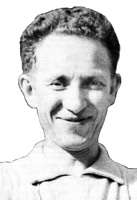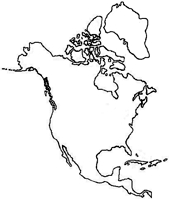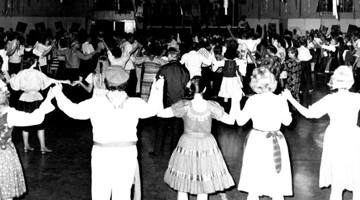
|
The Society of Folk Dance Historians (SFDH)
Folk Dance in North America
[
Home |
About |
Encyclopedia | CLICK AN IMAGE TO ENLARGE |

|
 Though folk dancing is now enjoying enormous popularity in Canada and the United States, it took many years – in fact centuries – to overcome the resistance to this form of recreation. Even to this day in many areas one may encounter old-fashioned prejudices against folk dancing such as existed in the days of the Puritans, albeit not quite as severe.
Though folk dancing is now enjoying enormous popularity in Canada and the United States, it took many years – in fact centuries – to overcome the resistance to this form of recreation. Even to this day in many areas one may encounter old-fashioned prejudices against folk dancing such as existed in the days of the Puritans, albeit not quite as severe.
The history of the American folk dance, though interesting, had a rather prolonged juvenile stage. Why has it taken so long for the folk dance to find its rightful place as a form of social recreation? Why do some people still look upon it with a dim and narrow view? The Puritans fled here from England because they desired freedom to practice their stern and joyless form of Christianity. Their beliefs were firmly implanted in our land and many traces of them still exist among their descendants.
These early fundamentalists were against anything they deemed frivolous. Thus dancing, music played on the "instruments of the devil," and even the celebration of Christmas, were considered evil. It required many years for Christmas to become a joyous holiday. In many areas the prejudice against folk dancing has not yet been overcome. That is why in the United States and Canada we have no colorful ritual, harvest, wedding, or work dances, or other highly developed forms. Aside from the play-party games, whatever eventually developed and took root did so indirectly, via the city-dwelling elite and latter-day immigrants.
The oldest form of the American folk dance is the play-party game, which has had a great following, though of late eclipsed by the square dance. Though the Puritans were against dancing and music, they were not against games. These games were quite clearly a form of dancing, but they were not usually performed with partners and they did not require instrumental music. The participants sang out the actions as they danced, or contrived actions to a song. This is the folk dance used in many areas to this day.
When international dances began to sweep the country and the recreational values of the folk dance began to be recognized, they were sometimes called folk "games" – "a rose by any other name."
During the period of the play-party game popularity, there were also other dances in existence. In the large cities of the east, the elite danced lancers, quadrilles, minuets, and in due time, waltzes, polkas, and various figure dances in couple formations. In the Cumberlands and other eastern hill areas where the Scots and Irish settled, a form of dance developed that showed the influence of Irish stepping, formations from the British Isles, and even Native American mannerisms of a sort. Later immigrants in the New England areas developed a style based on the English Country Dances from which our contra dance evolved. In the western mining towns of gold-rush days, still other forms of social dances came into being, figure dances for couples that were performed somewhat robustly.
Each of these forms contributed its share to the development of our square dance. From the play-party games came the singing, the calls, the patter. From the quadrilles and lancers came many of the graceful figures. Thus the rural people living on farms and in villages shared equally with the elite of the eastern cities in developing the popular square dance, a true American folk dance.
 International folk dancing had even greater difficulty in finding a place. For many years it was taught in schools as if it were gymnastics, so devitalized that it seemed a childish activity which even children did not enjoy. Thus, between the play-party games and square dances, both of which were regulated to barns, and the stiff joyless gymnastics which was called folk dancing, there was little to induce adults or teenagers to accept these activities as enjoyable social recreation.
International folk dancing had even greater difficulty in finding a place. For many years it was taught in schools as if it were gymnastics, so devitalized that it seemed a childish activity which even children did not enjoy. Thus, between the play-party games and square dances, both of which were regulated to barns, and the stiff joyless gymnastics which was called folk dancing, there was little to induce adults or teenagers to accept these activities as enjoyable social recreation.
European immigrants at the beginning of the 20th century, though they brought with them rich treasures in the form of folk dances from their native lands, often fell into the American pattern in order to "keep up with the Joneses." If folk dancing is considered juvenile and un-American by the Americans, then it was the same with them. There were some ethnic groups here and there, and two or three internationally minded groups who treated this subject of folk dancing as if they were societies formed for the preservation of historical curiosities or some fast-disappearing biological species.
Then came the decade of the 1930s and a series of world fairs at Chicago, New York, and San Francisco. Beginning at Chicago in 1933, these fairs presented the folk dances of many lands performed by groups in colorful costumes and some of the dancers were local ethnic groups. Some were groups imported from Europe. Great numbers of people wer able to watch them and found them as fascinating as the sword swallowers or the Hoochy-koochy dancers in the tents of "Little Egypt" that had been features of earlier fairs.
These audiences saw the fun the folk dancers were having, the unassumed smiles and happy faces. Unlike ballet or other forms of studio dancing, this dancing did not seem to require any special training, for it appeared easy enough. It aroused their curiosity and people were led to inquire further. At the time, they either joined the then existing groups, or formed new ones. These provided the large-scale public demonstrations that were the basis of the popularity of the folk dance that followed in their wake.
Folk dancing is the best kind of fun, and it is an enjoyable exercise. But the greatest service the folk dance renders is in the field of friendships. This aspect of the folk dance is worth more than dozens of solemn lectures about brotherhood. The international dances all tell us something of the backgrounds of the various nationalities and make us interested in knowing those people better. I've seen many an original anti-Semite become pro-Semite because of his enjoyment of the Israeli dances, and that without lectures, audio-visual aids, or television programs.
Look at the wonderful success folk dancing is having in the Province of Québec. Thousands of teenagers and youths gather for wholesome fun in the parish halls and city parks, not only in Montréal and Québec City, but in hamlets throughout the provinces, from Saint-Jovite and Saint-Jean to Chicoutimi and Rimouski.
However, its greatest merit is the fellowship it engenders. Those who dance together, hold each other's hands in the unending circle and, in spite of occasional jealousies over leadership here and there, do not fight or hate one another. Indeed, it is the exponent and propagator of world brotherhood.
DOCUMENTS
- North America, a continent.
- Vyts Beliajus, an article.
Adapted from "The Folk Dance in North America" by Vyts F. Beliajus
Viltis Magazine, Sept-Oct 1960, Volume XIX, V. F. Beliajus, Editor.
This page © 2018 by Ron Houston.
Please do not copy any part of this page without including this copyright notice.
Please do not copy small portions out of context.
Please do not copy large portions without permission from Ron Houston.